Ecommerce CRO: Start Winning Customers In 2025
Is your online store attracting many visitors but struggling to turn them into paying customers? You’re not alone. Let’s be real, running an eCommerce business in 2025 isn’t a walk in the park.
Many businesses face this challenge due to overlooked aspects of their website’s performance. The competition is fierce, customer expectations are sky-high, and every click counts. This is where eCommerce Conversion Rate Optimization (CRO) comes into play.
By optimizing key elements like site speed, user experience, and checkout processes, CRO helps turn casual browsers into loyal buyers. Even small improvements can unlock significant growth with the average eCommerce conversion rate between 2.5% and 3%.
In 2025, with increasing competition and evolving consumer behaviors, brands must refocus on CRO strategies to boost sales. Read this blog to learn the small adjustments that can lead to substantial gains in your bottom line.
What Is An eCommerce CRO?
A process to increase the percentage of visitors who take a particular action on your website is called Conversion Rate Optimization (CRO). CRO involves analyzing user behaviors, identifying barriers, and making data-driven improvements. For eCommerce brands, the action they try to boost is sales, but they can also focus on higher add-to-cart or lower cart abandonment rates.
Importance of CRO for eCommerce business:
- Increases Revenue: Even a small increase in conversion rates can significantly impact sales.
- Maximizes ROI: Helps you get more value from your existing traffic without spending extra on ads.
- Improves Customer Retention: Builds trust and satisfaction, encouraging repeat purchases.
Formula To Calculate Conversion Rate For An eCommerce Store
Conversion rate optimization (CRO) doesn’t deal in volume, it deals in percentages. Instead of bringing in more visitors, you focus on getting more people to complete key actions like the checkout process.
Conversion rate is the basic CRO metric you need to track. To calculate it— divide the number of conversions by the total number of visitors then multiply it by 100 to get the percentage.
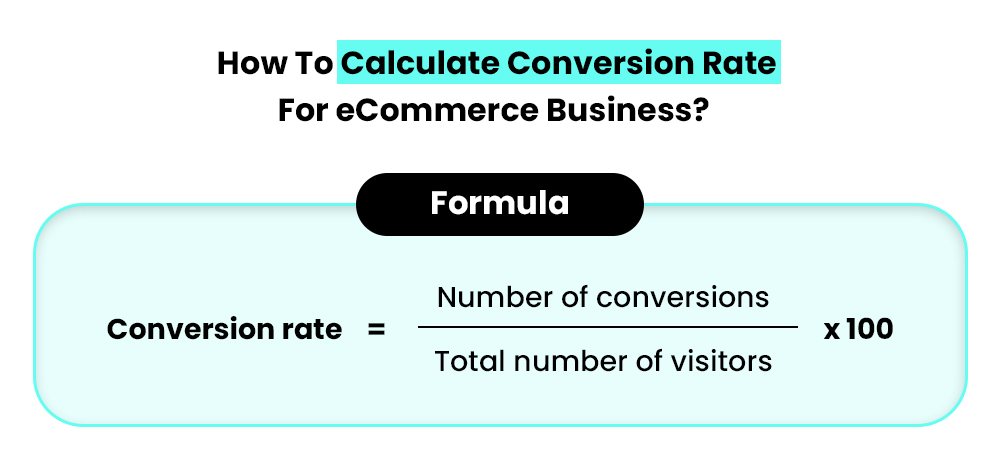
For instance, a product’s landing page with 1,200 visitors and 30 sales last month has a conversion rate of 2.5% which is decent.
Tips To Implement CRO Plans In Your eCommerce Business
To execute CRO tactics in your eCommerce business, focus on conducting website audits, building a CRO roadmap, and setting realistic goals. Utilize data-driven insights to reduce friction, boost conversions, and win more customers in 2025.
A. Conducting A Website Audit
A comprehensive website audit is essential for enhancing eCommerce conversion rates. This process involves evaluating various aspects of your site, including design, usability, content quality, and technical performance.
By identifying and addressing issues such as slow page load times, poor navigation, or unoptimized content, you can significantly improve user experience and increase conversions.
Research indicates that for every second delay in mobile page load, conversions can fall up by 20%.
Regular audits enable you to avoid potential problems, ensuring your website remains efficient and user-friendly, ultimately leading to higher customer satisfaction and sales.
Here are six steps to perform a CRO audit:
- Define your goals
- Identify priority pages
- Study user behavior
- Focus on quick wins
- Get a free website audit
- Let’s Talk
B. Building A CRO Roadmap
To implement CRO tips in your eCommerce business and build a roadmap, you should: define clear goals, collect data on user behavior, and identify areas of improvement. You must develop a hypothesis and run A/B testing on elements like the CTA button, product pages, product images, and the checkout process.
Here are key steps to build a CRO roadmap:
- Define clear goals and objectives
- Collect data and analysis
- Identify optimization areas
- Develop testing plans and hypothesis
- Implement A/B tests
- Analyze results
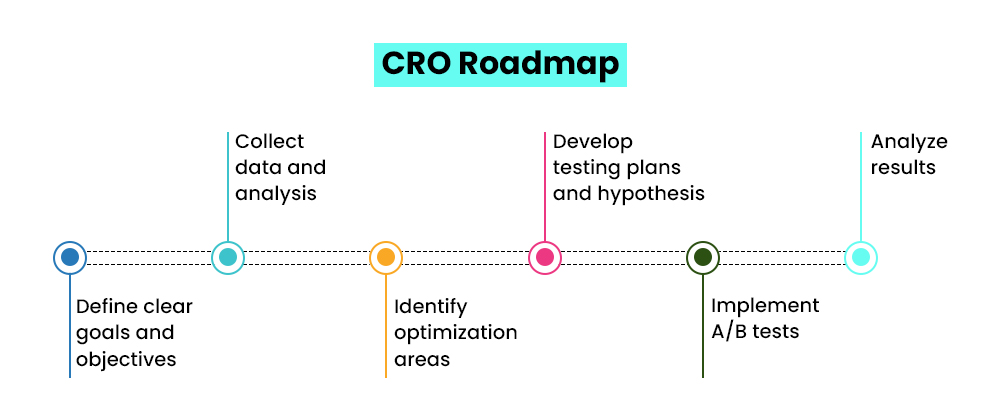
C. Setting Realistic Goals And Measuring Progress
Setting realistic goals and measuring progress are critical components of an effective eCommerce CRO strategy in 2025. Start by defining SMART goals— specific, measurable, achievable, relevant, and time-bound. For example, instead of aiming for a vague “increase in sales”, set a goal to “increase conversion rates by 10% in the next quarter.”
Next, identify key performance indicators (KPIs) that align with your goals, such as conversion rate, average order value, or cart abandonment rate. Regularly track and analyze these KPIs using analytic tools to monitor progress and identify areas for improvement.
Finally, use data-driven insights to refine your CRO strategies and tactics. If a particular change doesn’t yield the desired results, be prepared to adjust your approach and test new ideas. Remember, conversion rate optimization for eCommerce is an ongoing process of experimentation and optimization.
7 Key Tactics To Start Winning Customers Using Ecommerce CRO
Ecommerce CRO teaches teams about their customers to make a better future website and product decisions to contribute to a company’s financial health. Here are some key strategies that an eCommerce business can implement:
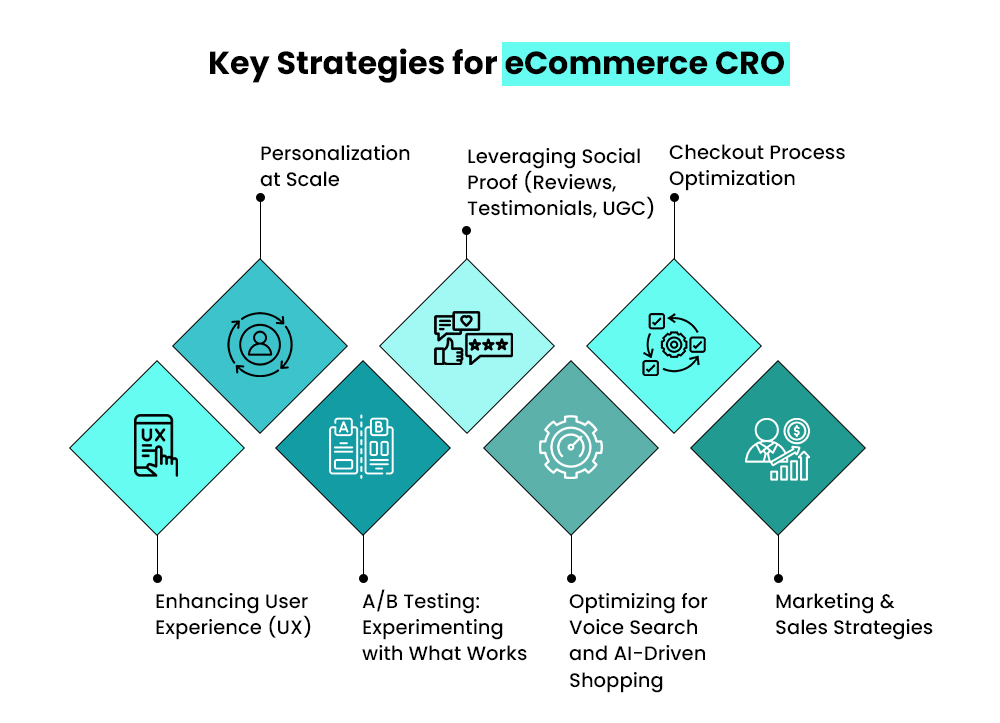
1. Enhancing User Experience (UX)
Enhancing user experience (UX) is essential for eCommerce businesses to increase conversions and retain customers in 2025. A seamless UX ensures that visitors can easily navigate your site, find products, and complete purchases without friction.
Key UX tactics like intuitive navigation, fast loading times, mobile optimization, and high-quality product images play a crucial role in eCommerce success. A smooth and engaging user experience keeps shoppers on your site and encourages them to take action. Increasing your UX budget by 10% can drive an impressive 83% boost in conversions.
For example, the Province of Canada website displays the Flag Fleece Sweatshirts with clear CTA buttons with smooth UX design, encouraging visitors to shop the collection.

By prioritizing UX enhancements, you can reduce bounce rates, increase customer satisfaction, and ultimately drive higher sales. Implementing clear call-to-actions (CTAs) and simplifying the checkout process can significantly improve the user journey, encouraging more visitors to become paying customers.
2. Personalization At Scale
Personalization is no longer a luxury but a necessity for online store owners. Personalized content like custom-written blog posts or buying guides can boost engagement and drive sales. Customers expect tailored experiences, and businesses that deliver will thrive.
Epsilon research shows that 80% of consumers are more likely to purchase a brand that offers personalized experiences.
Scaling personalization requires robust data infrastructure and sophisticated algorithms, but the payoff in terms of increased conversions and customer loyalty makes it a worthwhile investment. Focus on creating a truly individualized shopping experience for every customer.
As an eCommerce business, implement these tips:
- Utilize data to understand individual customer preferences, browsing history, and purchase behavior.
- Implement AI-powered solutions to automate personalized product recommendations, targeted promotions, and customized website content.
- Dynamic pricing and personalized email campaigns can further enhance the customer journey.
3. A/B Testing: Experimenting With What Works
A popular eCommerce CRO strategy, A/B testing allows eCommerce businesses to compare different versions of campaigns to decide which one performs better. By testing and refining, you can significantly enhance website conversions and drive more sales.
Common elements to test include landing pages, product pages, email campaigns, checkout processes, and onsite campaigns like signup forms or pop-ups. Tools like Optimizely for landing pages and Wisepops for onsite campaigns streamline this process, allowing you to run tests seamlessly.
For instance, Fuel Made, an ecommerce company performed A/B testing to increase conversion rates for the men’s grooming brand Live Bearded.
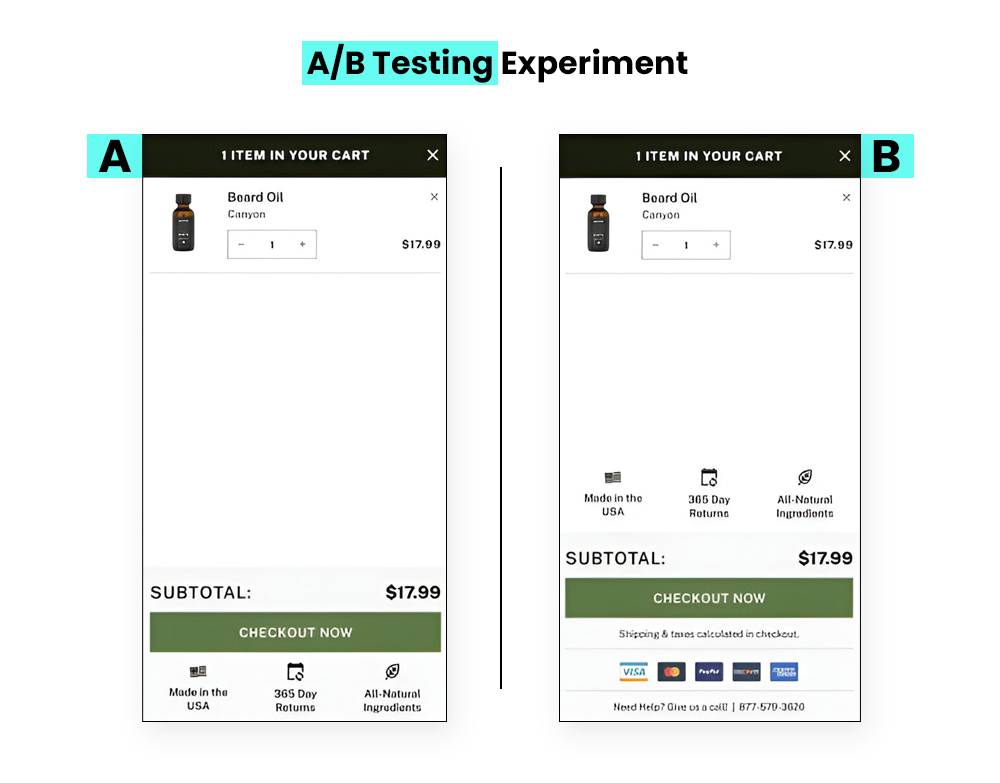
The success lies in changing one element at a time, such as— the color of the CTA button, a headline’s phrasing, or the placement of customer reviews. However, you can compare its performance against the original one.
Run tests in real-time, serving variations to equal segments of your audience, and collect sufficient data before concluding. By focusing on metrics like purchases or sign-ups, A/B testing helps refine strategies, turning visitors into loyal customers.
4. Leveraging Social Proof (Reviews, Testimonials, UGC)
Social proof is a cornerstone of successful eCommerce conversion rate optimization (CRO). User-generated content (UGC) which includes reviews, ratings, product images, etc. builds trust and credibility, directly influencing purchasing decisions.
According to BrightLocal, 79% of consumers trust online reviews as much as personal recommendations, making social proof a must-have for eCommerce brands.
Here are tips to use UGC for your eCommerce business effectively:
- Encourage user-generated content (UGC) by running contests or simply asking customers to share their experiences with your products on social media. Display these authentic photos and videos on your site to add a layer of credibility.
- Consider including social proof elements like star ratings, review snippets, and customer testimonials directly into the checkout process to reduce cart abandonment.
- Highlight positive media mentions or awards to further strengthen your brand’s reputation.
- Showing customer reviews on product pages reassures potential buyers about quality and reliability.
- Implement strategies like “Verified Buyer” tags to enhance trust or showcase “trending” products based on real-time purchases.
- Highlighting customer feedback in ads, emails, and product descriptions adds credibility and creates a sense of urgency.
For example, Beardbrand’s product page for Utility Bar soap demonstrates the product’s high customer rating.
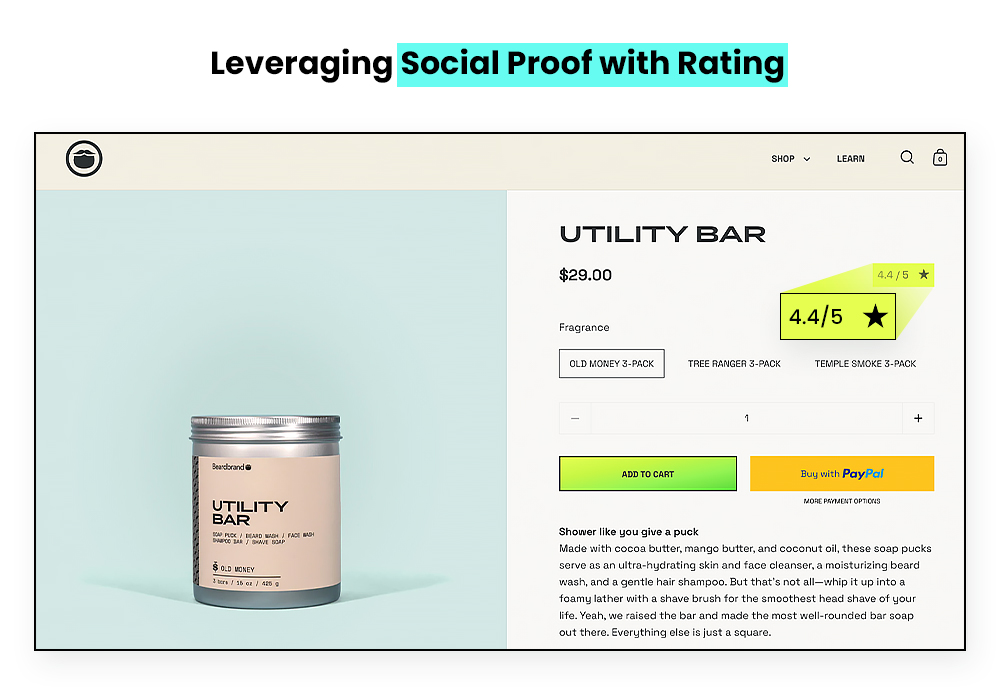
By displaying how others love and trust your brand, you create a powerful psychological incentive for new customers to follow suit. Leveraging social proof just doesn’t stop sales loss— it boosts customer acquisition and loyalty in a highly competitive eCommerce marketplace.
5. Optimizing For Voice Search And AI-Driven Shopping
Voice search and AI-driven shopping are transforming eCommerce and play a key role in improving conversion rate optimization (CRO). To optimize for voice search, focus on conversational keywords and ensure your product descriptions answer common queries.
For example, instead of “red sneakers,” use phrases like “Where can I buy red sneakers?” Enhancing mobile speed and integrating structured data can also improve visibility in voice search results.
AI-driven shopping tools, like personalized product recommendations, improve user experiences and boost conversions. Platforms like Amazon and Shopify leverage AI to suggest items based on browsing behavior, increasing the likelihood of purchase. As per the study over 80% of market research will rely on AI-driven insights by 2025.
By embracing voice search and AI, eCommerce brands can streamline the shopping journey, cater to evolving consumer habits, and win more customers in 2025.
– Also Read- How to Rank Higher in AI Search Engines like Google and Bing?
6. Checkout Process Optimization
One of the best eCommerce CRO techniques for an online business owner is having a smooth checkout process which can reduce cart abandonment and increase sales. The checkout should be seamless so the customers don’t have to hit any snags when they’re trying to buy a product.
As per Baymard’s research, over 1 out of 5 shoppers in the last quarter have abandoned a cart due to a “too long/complicated checkout process”.
As a business owner, follow these essential steps to ensure a smooth checkout flow:
- To complete a purchase, reduce the number of steps.
- To encourage transaction completion, design a simplified, clear, and linear progression.
- Provide several payment options like credit cards, digital wallets, pay later, etc.
- Incorporate upsell messages and trust symbols on the checkout page.
For instance, the Shopify Checkout is the best on the internet when it comes to checkout process optimization. It will enable you to develop a one-click checkout that is customized for your brand.
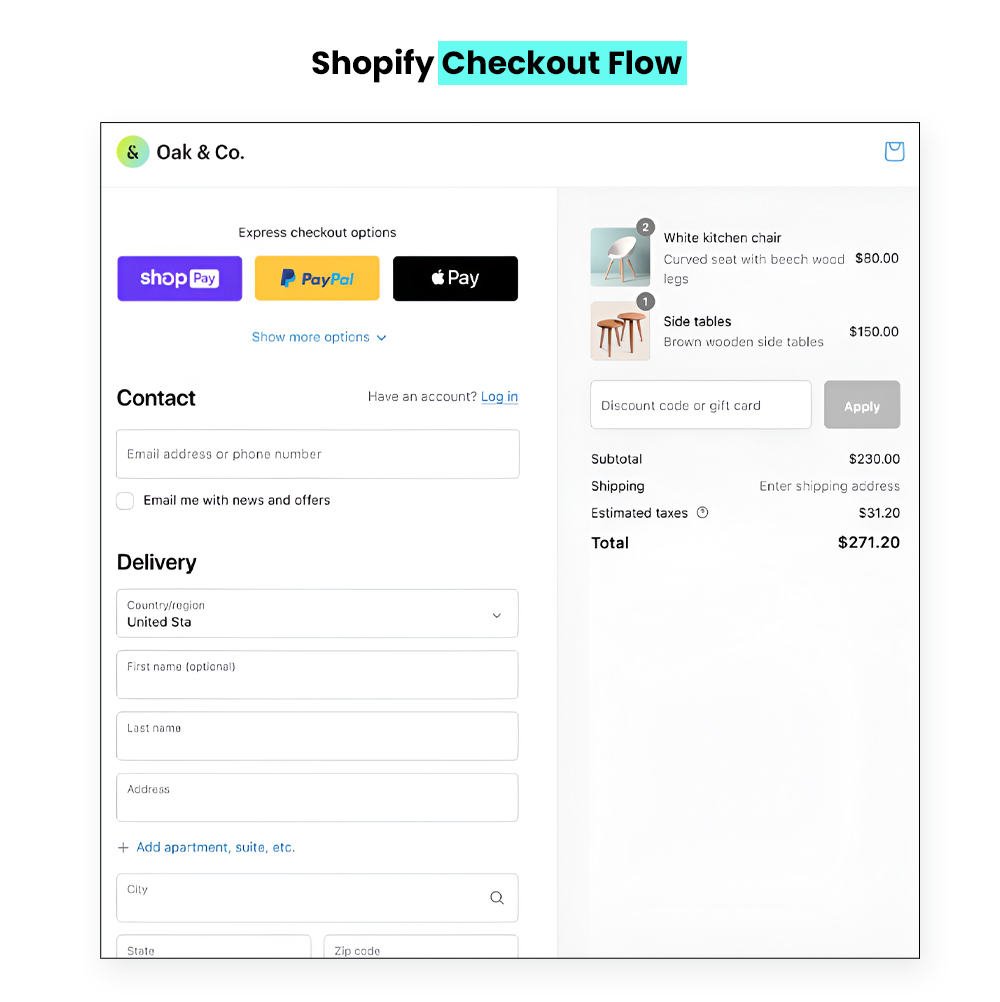
7. Marketing & Sales Strategies
Effective marketing and sales strategies are crucial for eCommerce conversion rate optimization (CRO) and driving long-term growth. Tailored email campaigns, personalized product recommendations, and dynamic website content make shoppers feel valued and encourage purchases.
Retargeting ads play a critical role in bringing back potential customers. Showing personalized ads featuring abandoned cart items or related products on social media and search engines can reignite interest and close the deal.
By integrating these strategies, businesses can not only boost conversions but also develop stronger customer relationships.
Common Mistakes That Lead To Losing Sales
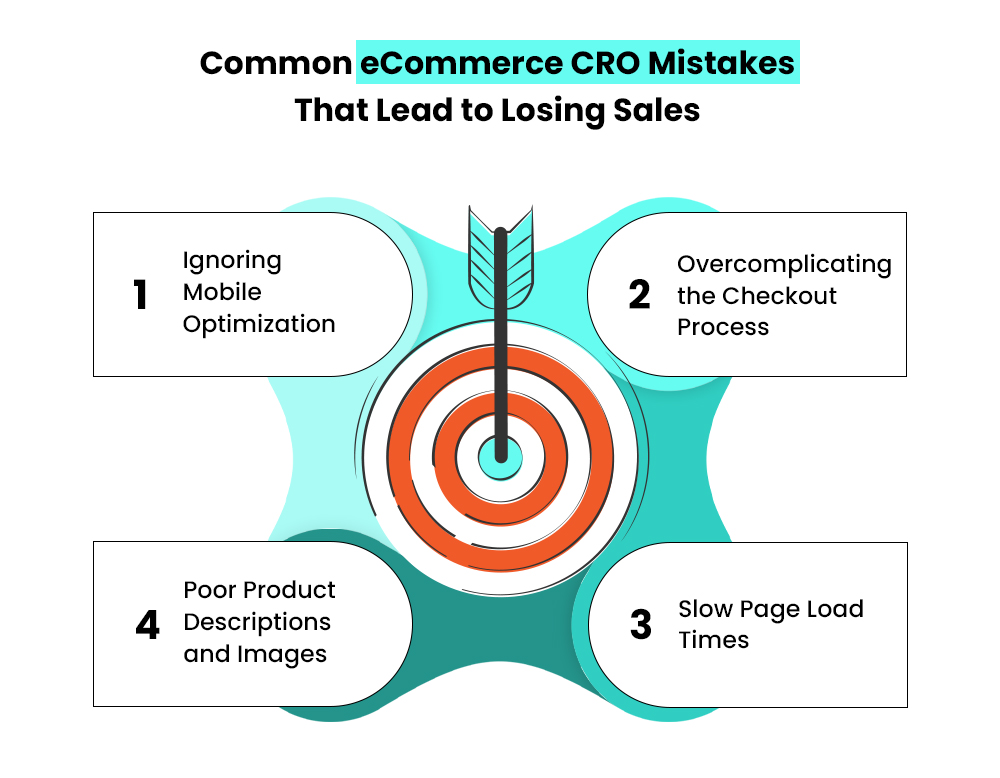
Check out these common eCommerce CRO mistakes that brands need to avoid so they don’t lose sales.
A. Ignoring Mobile Optimization
Overlooking mobile optimization is one of the biggest mistakes in eCommerce conversion rate optimization. Many business owners and CRO practitioners design websites and user experiences with desktops in mind, often neglecting how their site performs on mobile. This oversight can be costly as mobile commerce continues to dominate.
According to Statista, 63% of all eCommerce sales will occur on mobile devices by 2028.
If your website isn’t mobile-friendly—offering seamless navigation, fast load times, and an intuitive checkout process—you risk losing a significant portion of your audience. Your analytics likely show this shift, making mobile optimization a critical priority for driving conversions.
B. Overcomplicating the Checkout Process
A complicated checkout process is a major conversion letdown. The most important aspect of an eCommerce shopping experience is an easy checkout process with 56% of shoppers agreeing on it as per the study.
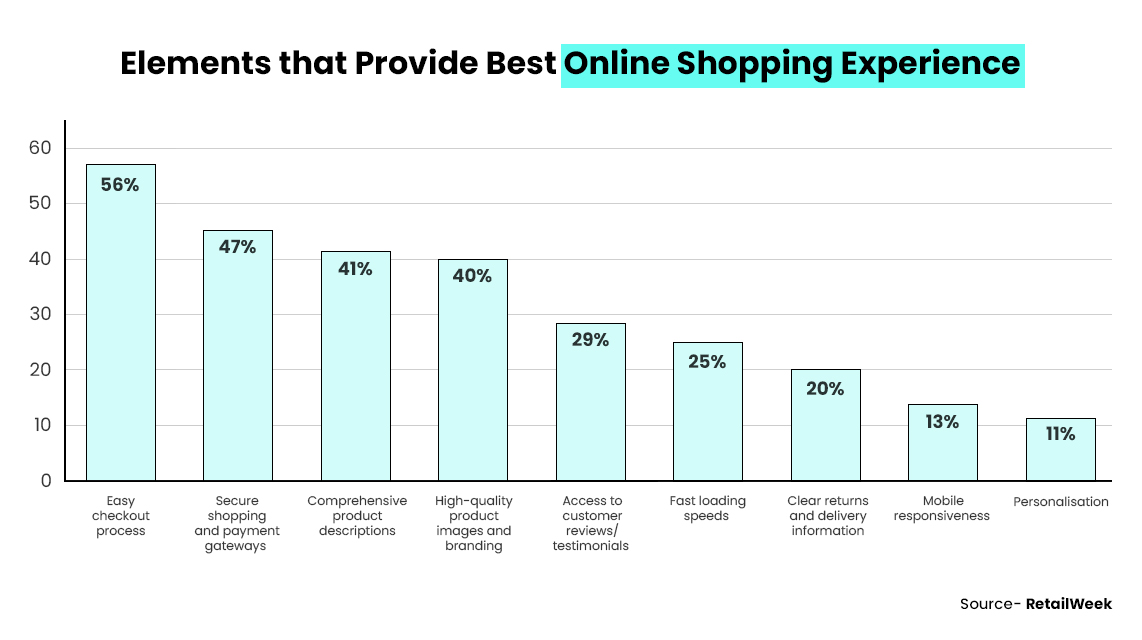
Three checkout mistakes that frustrate customers:
- There weren’t enough payment options.
- The process contains errors.
- The checkout process contains too many steps (like account creation, payment, etc. all on different pages).
When creating your checkout process, the key learning is to prioritize speed, test events thoroughly, and spot opportunities to reduce your information. Consider gaining customer feedback to ensure you’ve covered all the bases with these three points.
C. Slow Page Load Times
Slow page load times are one of the most detrimental mistakes in the eCommerce CRO checklist. Speed is critical, especially on mobile, where user expectations are higher. Shoppers are impatient— if your site doesn’t load quickly, they’ll leave for a competitor, costing you sales and customer loyalty.
Studies reveal that a 10-second page load time on mobile increases the bounce rate by a staggering 123% compared to a one-second loading speed.
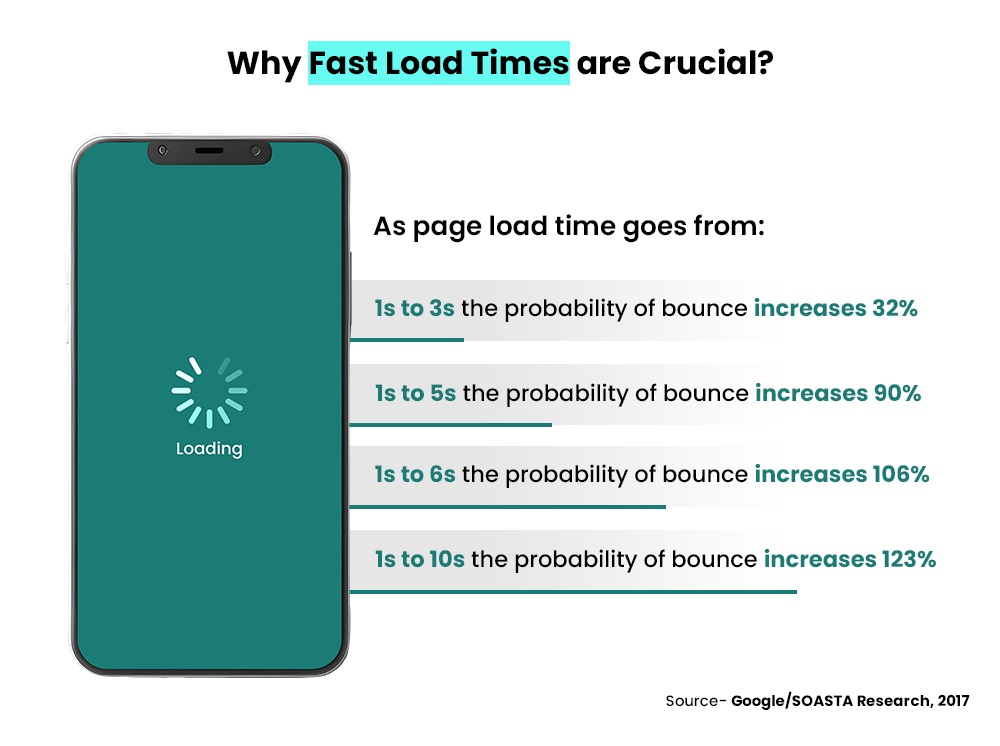
Optimizing page speed through strategies like compressing images, faster servers, and minimizing code can reduce load times, keep users engaged, and improve your conversion rates.
D. Poor Product Descriptions And Images
Poor or incomplete descriptions that don’t address customer questions lead to higher bounce rates and fewer conversions. It’s not just customers who value this information— Google’s Helpful content update prioritizes sites with detailed, accurate, and user-friendly content.
Using low-quality, non-zoomable images for failing to include videos can significantly harm customer engagement and trust. While on-page copy provides details, high-quality images, 3D designs, and videos offer a more immersive view of the product, helping customers visualize what they’re buying.
For example, Heinz created an amazing on-page copy that includes a clear image and description here in this image.
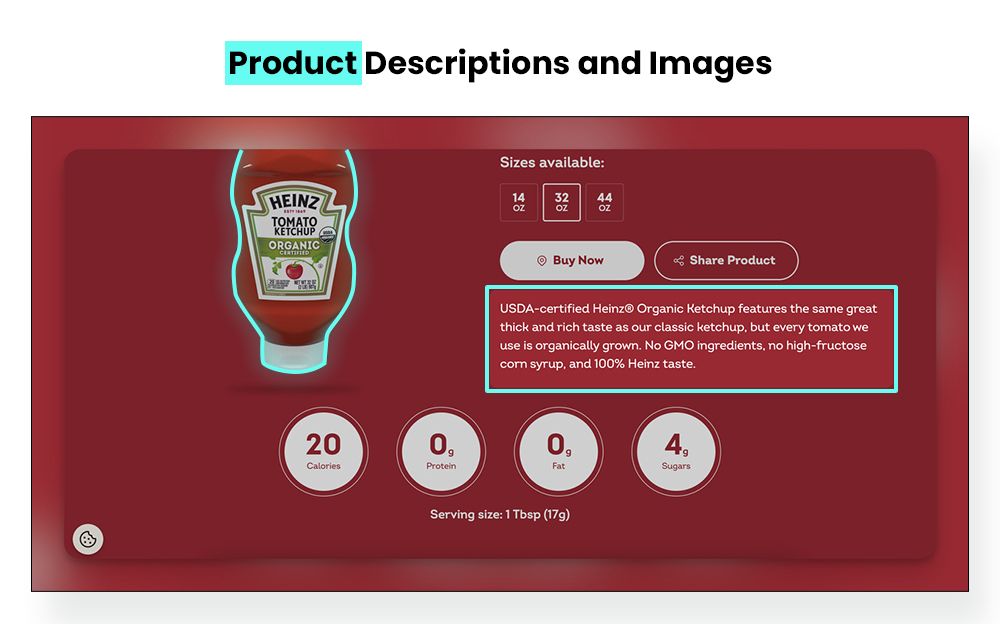
To avoid losing sales, include clear descriptions, engaging visuals, and a strong call-to-action to guide customers toward purchasing.
Conclusion- Final Note
In 2025, optimizing eCommerce CRO is no longer optional— it’s essential for staying competitive. By utilizing personalization, voice search, UGC, AI-driven tools, and effective marketing strategies, businesses can turn casual visitors into loyal customers.
Focusing on user experiences and urgency-driven tactics will help you win more sales and retain customers in a crowded marketplace. Remember, CRO isn’t just about immediate gains— it’s about building a long-term, growth-focused strategy.
Start implementing these tactics today and watch your eCommerce store thrive in 2025 and beyond! Reach out to our CRO experts to advance your business!

Mitolyn I truly appreciate your technique of writing a blog. I added it to my bookmark site list and will